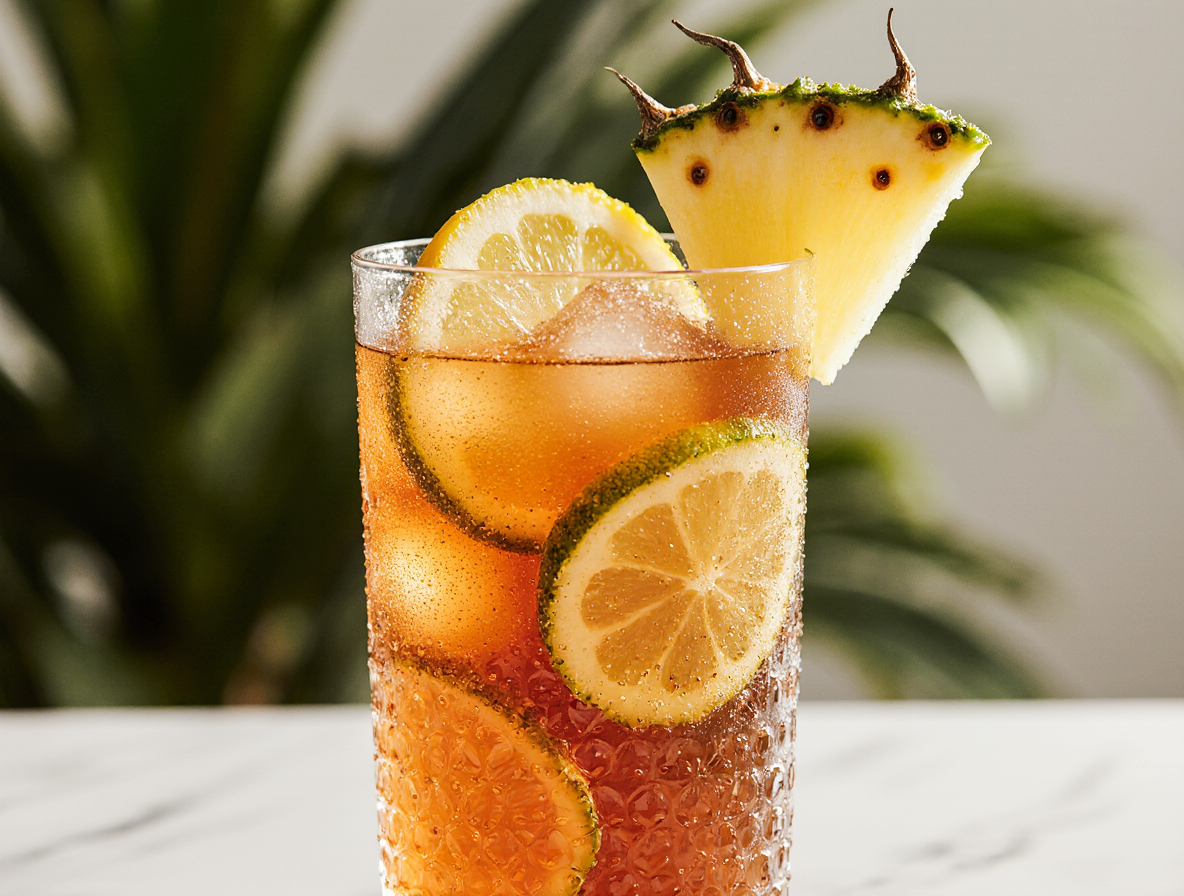How to Make Perfect Pineapple Iced Tea Recipe: A Tropical Summer Refresher
When summer temperatures soar, a refreshing pineapple iced tea recipe becomes our ultimate savior. This tropical blend captures the essence of summer in a glass, combining zesty lemon tartness with sweet pineapple for a crisp, revitalizing experience.
Whether you’re hosting a neighborhood BBQ or simply want to enjoy a cool drink on your porch, this pineapple sweet tea requires no special mixology skills. In fact, with just 20 minutes of prep time and 10 minutes of cooking, we can create a delicious pineapple fruit tea that’s perfect for quenching thirst on hot days. Furthermore, this tea with pineapple juice yields 20 servings, making it ideal for gatherings or storing in the refrigerator for whenever you need a refreshing sip.
In this guide, we’ll walk you through everything you need to know about creating the perfect unsweetened pineapple iced tea recipe that you can customize to your taste preferences.
Choosing the Right Ingredients for Pineapple Iced Tea
The secret to a spectacular pineapple iced tea recipe lies in selecting high-quality ingredients. Let’s explore what makes this tropical drink truly shine.
Tea Base – Black vs. Green
Black tea serves as an excellent foundation for pineapple iced tea due to its robust flavor that balances perfectly with the sweetness of pineapple. I prefer using basic black tea bags, slightly increasing the tea-to-water ratio for a more intense flavor. For a lighter alternative, green tea offers a fresh, grassy taste with slightly more L-theanine than black tea. Green tea also contains fewer caffeine and requires brewing at a lower temperature of around 175°F to prevent bitterness.
Pineapple Options
Fresh pineapple creates the most vibrant flavor profile for your pineapple sweet tea. Although slicing requires extra effort, the bright tropical taste is unmatched. If fresh isn’t available, frozen pineapple chunks work well too—just remember to save the juice during thawing for added sweetness. However, avoid canned pineapple or store-bought juice with additives and refined sugars.
Sweetener Selections
Agave nectar complements pineapple tea flavors beautifully. Additionally, honey provides a natural sweetness that pairs wonderfully with the tropical notes. For a sugar-free version, monk fruit sweetener or stevia work well. Traditional recipes often use simple syrup (equal parts water and sugar).
Enhancing Ingredients
A splash of lemon juice (approximately 1/3 cup per quart of tea) adds brightness while cutting through sweetness. Fresh mint leaves create a refreshing dimension—lightly crush them before adding to release their aromatic oils.
For an unexpected twist, a pinch of baking soda reduces bitterness in the tea. Other herbs like basil, lemongrass, rosemary, or ginger can provide unique flavor variations.
The beauty of pineapple fruit tea lies in its versatility—experiment with ingredient ratios until you discover your perfect blend of tea with pineapple juice. Remember that using organic, preservative-free ingredients will yield the most authentic and delicious unsweetened pineapple iced tea recipe.
Step-by-Step Guide to Making Pineapple Iced Tea
Creating this delicious pineapple iced tea recipe requires minimal effort but delivers maximum refreshment. I’ve perfected two foolproof methods that guarantee spectacular results every time.
Hot Brewing Method (Quick Preparation)
- Bring 4 cups of water to a boil in a large saucepan. Once boiling, remove from heat immediately.
- Add 7-8 tea bags to the hot water. For optimal flavor, cover the pan and let steep for 3-5 minutes – any longer risks releasing bitter tannins.
- Remove the tea bags, squeezing them gently to extract remaining liquid. Stir in 2 tablespoons of sugar until completely dissolved.
- Pour this tea concentrate into a large pitcher, then add 1 cup of unsweetened pineapple juice and 1/3 cup of lemon juice for brightness.
- Allow the mixture to cool slightly at room temperature before refrigerating. This prevents cloudiness in your pineapple sweet tea.
Cold Brewing Method (Smooth Flavor)
Alternatively, cold brewing extracts flavors more gently, releasing fewer tannins for an exceptionally smooth pineapple fruit tea:
- Place tea bags (1 bag per cup of water) directly into a pitcher of cool water.
- Refrigerate overnight or for at least 8 hours. Unlike hot brewing, this method is forgiving – steeping for 8, 12, or even 24 hours works beautifully.
- Remove tea bags, then stir in pineapple juice to taste.
Sweetening Tips
Remember that sugar and honey don’t dissolve well in cold liquids. For best results, either:
- Add sweeteners while tea is still warm from hot brewing
- Create simple syrup by simmering equal parts sugar and water until dissolved
Serving Suggestions
Serve over ice and garnish with fresh pineapple slices or wedges. For an eye-catching presentation, add fresh mint leaves or lemon slices. Store your pineapple iced tea in a sealed glass container (rather than plastic) to preserve its delicate flavor, and consume within 48 hours for optimal taste.
The unsweetened pineapple iced tea recipe can be customized endlessly – try adding frozen pineapple chunks as ice cubes for additional sweetness without dilution!
Creative Variations and Serving Ideas
My favorite thing about pineapple iced tea is its versatility as a base for countless creative variations. Once you’ve mastered the basic recipe, it’s time to explore exciting twists that transform this tropical refresher.
Spirited Transformations
For adult gatherings, pineapple iced tea makes an excellent cocktail base. Spiced rum pairs wonderfully with the tropical notes, creating a delicious “boozy pineapple sweet tea.” Vodka offers a cleaner flavor profile—simply mix it with your tea along with fresh mint, orange juice, and a squeeze of lime for a refreshing martini-style drink. Bourbon enthusiasts can combine their favorite Four Roses bourbon with pineapple tea for a sophisticated southern-inspired beverage that balances the caramel notes of bourbon with tropical sweetness.
Smoothie Creations
Beyond cocktails, pineapple tea works beautifully in smoothies. Mix cold unsweetened pineapple iced tea with:
- Frozen pineapple chunks (½ cup)
- Frozen mango (½ cup)
- Half a banana
- A tablespoon of agave for sweetness
This combination creates a refreshing 204-calorie smoothie with only 1g of fat and 2g of protein. For a healthier green tea version, blend matcha powder with vanilla frozen yogurt, ice cubes, and pineapple for an energizing treat.
Presentation Magic
Elevate your pineapple fruit tea with creative serving ideas. Instead of regular ice cubes, freeze pineapple chunks in ice cube trays—they add flavor without diluting your drink. For parties, serve in mason jars garnished with:
- Pineapple strips or wedges
- Fresh mint sprigs
- Lemon slices
- Melissa’s Sugar Cane Swizzle Stix
As an added bonus, this pineapple iced tea keeps well when refrigerated in a covered container for up to three days, making it perfect for advance preparation. Consequently, you can enjoy this tropical refresher throughout the week or prepare it ahead for summer gatherings.
Conclusion
Pineapple iced tea certainly stands as one of summer’s most delightful beverages. Throughout this guide, we’ve explored how this tropical refresher combines simplicity with incredible flavor, making it perfect for both casual sipping and entertaining guests.
The beauty of this recipe lies primarily in its adaptability. Whether you prefer the robust flavor of black tea or the lighter notes of green tea, both work wonderfully as bases for your tropical creation. Additionally, your choice between fresh, frozen, or juice forms of pineapple allows flexibility based on what’s available in your kitchen.
Hot brewing offers quick results when you’re pressed for time, while cold brewing rewards patience with exceptionally smooth flavors. Regardless of your method, this versatile drink transforms easily from family-friendly refreshment to sophisticated cocktail with just a splash of rum, vodka, or bourbon.
Last but certainly not least, presentation matters! Simple garnishes like fresh pineapple wedges, mint sprigs, or homemade pineapple ice cubes elevate this drink from merely tasty to visually stunning. The fact that you can prepare it days ahead makes pineapple iced tea a practical choice for busy hosts.
Next time temperatures soar, this pineapple iced tea recipe will undoubtedly become your go-to refreshment. After all, few drinks capture summer’s essence quite as perfectly as this sweet, tangy, and utterly refreshing tropical blend.
FAQs
Q1. What’s the secret to making perfect pineapple iced tea? The key is using high-quality ingredients, including a robust black tea base, fresh or frozen pineapple, and a touch of lemon juice. Brew the tea properly, mix in the pineapple juice while still warm, and chill thoroughly before serving over ice.
Q2. Can I use green tea instead of black tea for pineapple iced tea? Yes, you can use green tea for a lighter flavor. Brew it at a lower temperature (around 175°F) to prevent bitterness. Green tea offers a fresh, grassy taste that pairs well with pineapple, and it contains slightly more L-theanine than black tea.
Q3. What are the health benefits of drinking pineapple tea? Pineapple tea offers several health benefits, including fighting oxidative stress in cells, potentially lowering blood pressure, and providing anti-inflammatory properties. It may also help reduce the risk of heart disease and offer pain-fighting properties.
Q4. How can I turn my pineapple iced tea into a cocktail? To create a cocktail, simply add your choice of spirits to the pineapple iced tea. Spiced rum complements the tropical notes well, while vodka offers a cleaner flavor profile. For a southern-inspired drink, try mixing it with bourbon to balance the caramel notes with tropical sweetness.
Q5. How long can I store homemade pineapple iced tea? When stored in a sealed glass container in the refrigerator, homemade pineapple iced tea can last up to three days. For the best flavor, consume within 48 hours. Avoid storing in plastic containers to preserve the delicate flavor of the tea.


